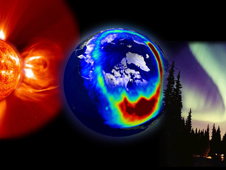- NASA Home
- > News & Features
- > News Topics
- > Looking at Earth
- > Features
Feature
Text Size
SABER Offers a New Way to Study Earth’s Ionosphere and the Effect of Geomagnetic Storms
05.08.09
 Three perspectives on the events that create geomagnetic storms: A storm from the Sun, a global perspective of an auroral event as seen from space and aurora as seen from Earth. Researchers at NASA’s Langley Research Center are using the Sounding of the Atmosphere using Broadband Emission Radiometry (SABER) satellite to take new measurements of the E-region of the ionosphere — an active, charged layer that is crucial for the transmission of satellite, radio and GPS signals.
Credit: NASA SOHO Mission.
Three perspectives on the events that create geomagnetic storms: A storm from the Sun, a global perspective of an auroral event as seen from space and aurora as seen from Earth. Researchers at NASA’s Langley Research Center are using the Sounding of the Atmosphere using Broadband Emission Radiometry (SABER) satellite to take new measurements of the E-region of the ionosphere — an active, charged layer that is crucial for the transmission of satellite, radio and GPS signals.
Credit: NASA SOHO Mission.> Larger image
Researchers have developed a new way to measure Earth’s aurora and are using the technique to learn more about a region of the ionosphere that plays a key role in satellite and radio communications during geomagnetic disturbances.
Shortly after NASA’s Sounding of the Atmosphere using Broadband Emission Radiometry (SABER) mission began routine operation in 2002, a solar-geomagnetic storm blasted the ionosphere and lit up sensors on the orbiting instrument in a way that researchers did not expect to see.
SABER provided a glimpse of a strong, nighttime infrared radiation emission by positively charged nitric oxide – a measurement that hadn’t been made globally before but provided an excellent opportunity to study auroral events in the E-region of the ionosphere. The region is one of three ionized layers that make up the far reaches of Earth’s atmosphere. It turned out that SABER is well-suited to measure Earth’s aurora, that phenomenon of solar winds clashing with the planet’s magnetic field. Scientists at NASA’s Langley Research Center are now trying to build on that discovery to improve a model of the ionosphere and take further measurements.
The ionosphere is an abundant layer of electrons and ionized atoms and molecules that stretches from about 30 miles above the surface to the edge of space at about 600 miles. The region acts as a reflector, allowing radio signals to ricochet across oceans and allowing pilots, soldiers and commuters to have GPS signals beamed into critical devices at their fingertips.
The ionosphere’s E-region is still not completely understood, and scientists are trying to pin down its basic physics and chemistry. It is largely inaccessible to satellite measurements and only a small number of ground-based measurements are routinely made. Until now, there has not been a suitable method to globally observe the region’s electron density and behavior during geomagnetic storm events.
Observing infrared emissions from positively charged nitric oxide can quantify the E-region’s response to solar-geomagnetic storms, said NASA Langley’s Christopher J. Mertens. Those events can cause radio blackouts, hamper electrical grids and distort GPS readings.
“When we observe it, it’s telling us about the electron density in the region,” Mertens said. “We’re seeing the response in the E-region to geomagnetic storms. That’s interesting in itself.”
It is the observing of those solar events that Mertens and his fellow researchers are trying to improve. Mertens and Jose Fernandez are working on a correction to the International Reference Ionosphere model. The empirical model, which estimates electron density in the ionosphere among other things, is largely supported by data from a network of ground-based incoherent scatter radars for E-regions electron densities. The correction would improve the model’s ability to estimate the electron density of the ionosphere and to better understand its reaction to solar geomagnetic storms, said Fernandez, who is doing his post-doctoral work on the project.
“We’re looking for a ratio of storm-time data and quiet-time data,” said Fernandez, who is doing post-doctoral work on the issue through the Oak Ridge Associated Universities consortium. “We’re going to have that ratio for the whole coverage of the Earth.”
Mertens plans on proposing a rocket mission from Alaska for next year to better study the E-region’s response to solar storms using this method.
The rocket mission would launch from the Poker Flats region in Alaska. The rocket would be loaded with an infrared interferometer, near-infrared to ultraviolet photometers, a mass spectrometer, and would be launched during a period of auroral activity, Mertens said.
Flying the instruments through a solar-geomagnetic event would provide the best measuring stick yet for this new method of observing the Earth’s aurora.
“It’s an important process that needs to be considered in order to understand the thermal balance of the upper atmosphere,” Mertens said.
Related Links:
> SABER and the TIMED Mission
NASA's Earth Science News Team